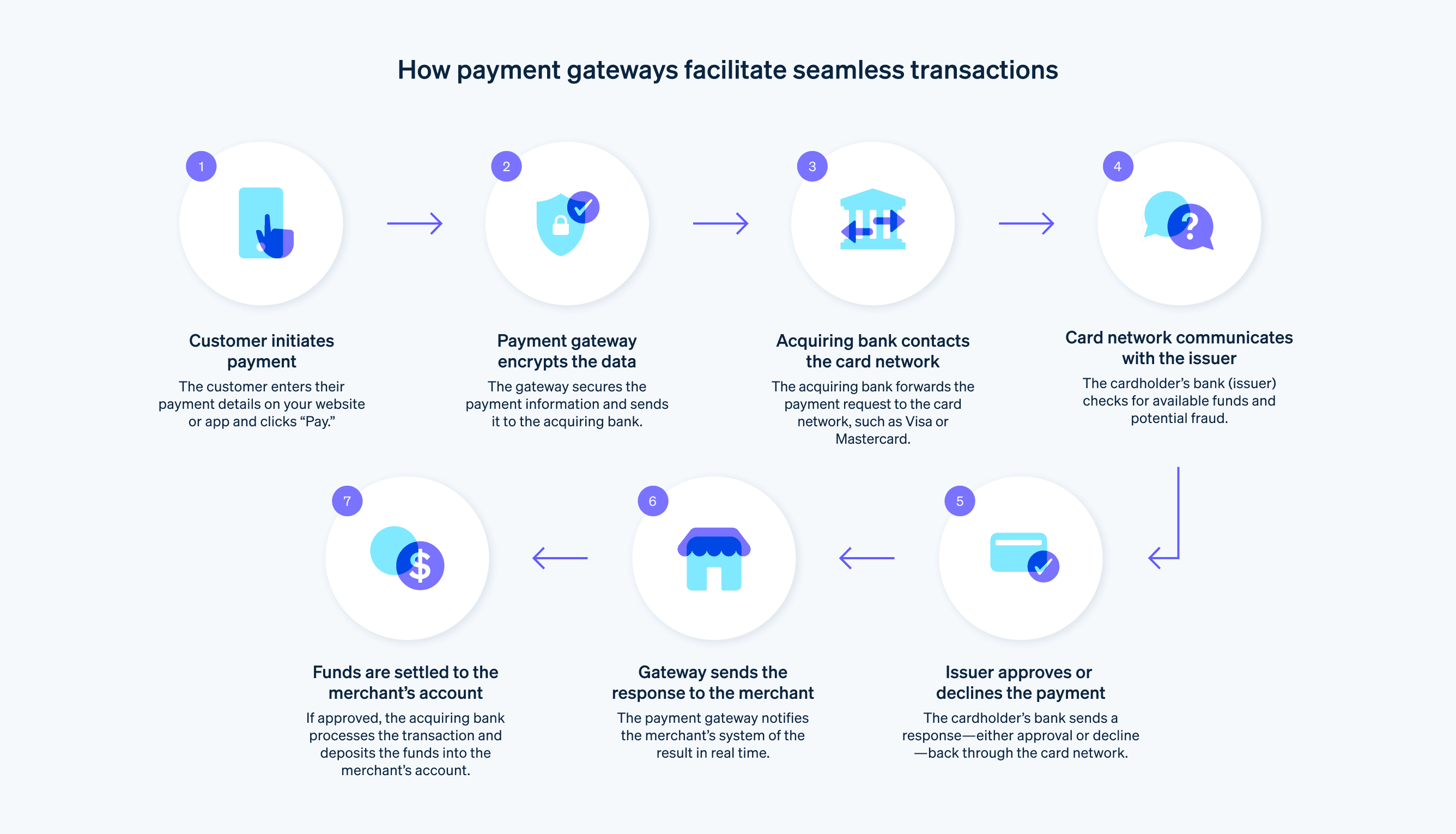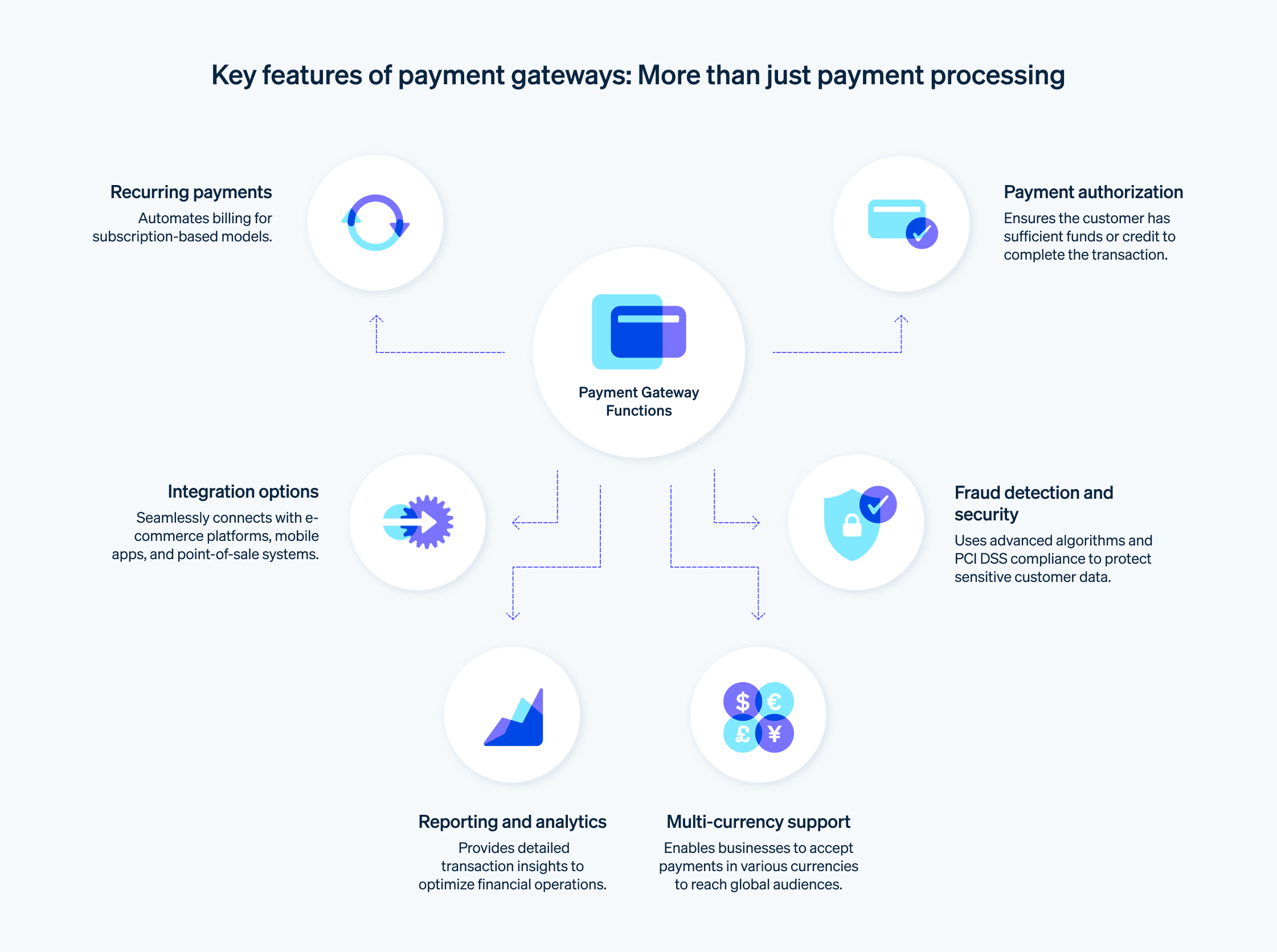มีการคาดการณ์ว่าตลาดประมวลผลการชําระเงินจะมีมูลค่าถึง 1.98 แสนล้านดอลลาร์สหรัฐในปี 2032 โดยเพิ่มขึ้นอย่างมากจากมูลค่า $6.56 หมื่นล้านดอลลาร์สหรัฐในปี 2022 ตัวเลขดังกล่าวเน้นให้เห็นความสําคัญของโซลูชันการประมวลผลการชําระเงินที่เรียบง่าย มีประสิทธิภาพ และปลอดภัยสําหรับธุรกิจที่รับชําระเงินออนไลน์
ลูกค้าคาดหวังมากขึ้นว่าจะเห็นวิธีการชําระเงินที่หลากหลายและได้รับประสบการณ์การชําระเงินที่ราบรื่น ปัจจุบัน ธุรกิจจึงต้องประเมินตัวเลือกการประมวลผลการชําระเงินที่หลากหลายมากขึ้น บางส่วนพิจารณาว่าควรสร้างเกตเวย์การชําระเงินของตัวเองหรือไม่ การพัฒนาโซลูชันที่ออกแบบเองนี้จะช่วยให้ธุรกิจสามารถควบคุมธุรกรรมของตัวเอง ปรับปรุงประสบการณ์ของลูกค้า และลดต้นทุนธุรกรรมได้มากขึ้น อย่างไรก็ตามกระบวนการสร้างเกตเวย์การชําระเงินนั้นซับซ้อนต้องใช้การวางแผนและการดําเนินการอย่างรอบคอบ
ต่อไปนี้คือคู่มือสําหรับการสร้างเกตเวย์การชําระเงินของคุณเอง ซึ่งจะช่วยให้คุณเข้าใจข้อกําหนด ประโยชน์ และความท้าทายที่อาจเกิดขึ้นได้ดียิ่งขึ้น
บทความนี้ให้ข้อมูลอะไรบ้าง
- ผู้ประมวลผลการชําระเงินคืออะไร
- เกตเวย์การชําระเงินคืออะไร
- เกตเวย์การชําระเงินทํางานอย่างไร
- ผู้ประมวลผลการชําระเงินมีหลักการทํางานอย่างไร
- ประโยชน์ของการพัฒนาเกตเวย์การชําระเงินของคุณเอง
- อุปสรรคในการสร้างเกตเวย์การชําระเงินของคุณเอง
- วิธีสร้างเกตเวย์การชําระเงินของคุณเอง
ผู้ประมวลผลการชําระเงินคืออะไร
ผู้ประมวลผลการชําระเงินคือนิติบุคคลด้านการเงินที่ธุรกิจแต่งตั้งให้จัดการธุรกรรมบัตรเครดิตและบัตรเดบิต บทบาทนี้มีความสําคัญต่อการดําเนินงานของอีคอมเมิร์ซที่รับชำระเงินด้วยบัตรทั้งทางออนไลน์และออฟไลน์
ผู้ประมวลผลการชําระเงินช่วยอํานวยความสะดวกในการโอนข้อมูลธุรกรรม อย่างไรก็ตาม บทบาทของผู้ประมวลผลการชําระเงินไม่ได้มีแค่การโอนข้อมูลเท่านั้น เพราะยังให้บริการอื่นๆ ที่ช่วยรักษาความปลอดภัย ตรวจสอบสิทธิ์ และเพิ่มประสิทธิภาพการทำธุรกรรมผ่านบัตรสําหรับธุรกิจต่างๆ ด้วย
เกตเวย์การชําระเงินคืออะไร
เกตเวย์การชําระเงินคือเทคโนโลยีที่ธุรกิจต่างๆ ใช้เพื่อรับชําระเงินผ่านบัตรและกระเป๋าเงินดิจิทัลจากลูกค้า คำนี้ไม่ได้หมายถึงแค่เครื่องอ่านบัตรที่พบเห็นได้ในร้านค้าปลีกแบบมีหน้าร้านเท่านั้น แต่ยังรวมถึงโซลูชันแบบเดียวกันสำหรับใช้ทางออนไลน์ที่ดูแลจัดการกระบวนการชําระเงินสําหรับอีคอมเมิร์ซ การค้าบนอุปกรณ์เคลื่อนที่ และธุรกรรมที่ไม่ต้องแสดงบัตรจริง (CNP)ด้วย
เกตเวย์การชําระเงินช่วยอํานวยความสะดวกในการสื่อสารระหว่างองค์ประกอบต่างๆ ที่เกี่ยวข้องกับกระบวนการทําธุรกรรม โดยจะส่งข้อมูลบัตรเครดิตจากเว็บไซต์ของธุรกิจไปยังเครือข่ายการชําระเงินเพื่อประมวลผล และส่งคืนรายละเอียดธุรกรรมและคําตอบจากเครือข่ายการชําระเงินกลับไปที่เว็บไซต์
เกตเวย์การชําระเงินทํางานอย่างไร
เกตเวย์และผู้ประมวลผลการชําระเงินจะทําหน้าที่เป็นตัวกลางระหว่างธุรกิจกับลูกค้าเพื่อให้ดำเนินการธุรกรรมแต่ละรายการได้อย่างปลอดภัยและรวดเร็ว โดยปกติกระบวนการจะประกอบด้วยหลายขั้นตอน โดยเริ่มจากลูกค้าชําระเงินค่าสินค้าหรือบริการ และสิ้นสุดลงด้วยการที่ธุรกิจได้รับการชําระเงิน
เกตเวย์การชําระเงินมีหน้าที่รับผิดชอบที่สําคัญหลายประการในระหว่างกระบวนการธุรกรรม ได้แก่
การเข้ารหัส
เมื่อลูกค้าส่งคําสั่งซื้อ เกตเวย์จะเข้ารหัสข้อมูลการชำระเงินก่อนจะส่งกลับไปยังเซิร์ฟเวอร์ของธุรกิจ จากนั้น เกตเวย์จะส่งข้อมูลธุรกรรมไปยังผู้ประมวลผลการชําระเงินที่ธนาคารผู้รับบัตรของธุรกิจใช้คําขออนุมัติ
ผู้ประมวลผลการชําระเงินส่งข้อมูลธุรกรรมไปยังเครือข่ายบัตร ซึ่งจะนําส่งข้อมูลดังกล่าวไปยังธนาคารที่ออกบัตรของลูกค้าเพื่ออนุมัติหรือปฏิเสธธุรกรรมดำเนินการตามคําสั่งซื้อ
จากนั้นผู้ประมวลผลจะส่งต่อการอนุมัติที่เกี่ยวข้องกับธุรกิจและลูกค้าไปยังเกตเวย์การชําระเงิน เมื่อเกตเวย์ได้รับการตอบกลับนี้แล้ว เกตเวย์จะส่งต่อข้อมูลการตอบกลับไปยังเว็บไซต์ของธุรกิจ (หรืออินเทอร์เฟซใดก็ตามที่ประมวลผลการชําระเงิน) เพื่อดําเนินการชําระเงินให้เสร็จสิ้น หากธุรกรรมได้รับการอนุมัติ ธุรกิจจะสามารถดําเนินการตามคําสั่งซื้อได้การชําระเงิน
เมื่อสิ้นสุดวัน ธุรกิจจะส่งการอนุมัติวงเงินที่ได้รับอนุมัติทั้งหมดให้แก่ธนาคารผู้รับบัตรของตนเพื่อดำเนินการชําระเงิน ธนาคารจะฝากเงินที่ได้รับอนุมัติทั้งหมดเข้าบัญชีของธุรกิจที่กำหนดไว้ โดยอาจดำเนินการแบบรายวัน รายสัปดาห์ หรือตามกําหนดการอื่นๆ ตามที่ตกลงกันไว้
เกตเวย์การชําระเงินช่วยให้การทําธุรกรรมออนไลน์มีความราบรื่น ปลอดภัย และรวดเร็วด้วยการมอบเส้นทางการทำธุรกรรมที่ปลอดภัยระหว่างลูกค้า ธุรกิจ และผู้ประมวลผลการชําระเงิน ไม่เพียงเท่านั้น เกตเวย์การชําระเงินยังใช้มาตรการรักษาความปลอดภัยต่างๆ เช่น การเข้ารหัส SSL และเครื่องมือป้องกันการฉ้อโกงเพื่อปกป้องข้อมูลที่ละเอียดอ่อน เช่น หมายเลขบัตรเครดิตและข้อมูลส่วนบุคคลอื่นๆ

ผู้ประมวลผลการชําระเงินมีหลักการทํางานอย่างไร
บางครั้งเราจะใช้คําว่า "ผู้ประมวลผลการชําระเงิน" และ "เกตเวย์การชําระเงิน" แทนกัน แต่จริงๆ แล้ว 2 คำนี้หมายถึง 2 ขั้นตอนที่แตกต่างกันในวงจรการชําระเงิน ต่อไปนี้คือคําอธิบายอย่างละเอียดเกี่ยวกับวิธีการทํางานขององค์ประกอบทั้ง 2 ส่วนนี้
ผู้ประมวลผลการชําระเงิน
ผู้ประมวลผลการชําระเงินคือบริษัทที่ทํางานร่วมกับธุรกิจเพื่อจัดการการประมวลผลธุรกรรมสําหรับธนาคารผู้รับบัตร เมื่อลูกค้าชําระเงินค่าสินค้าหรือบริการด้วยบัตรเครดิตหรือบัตรเดบิต ผู้ประมวลผลการชําระเงินจะดําเนินงานหลายอย่างโดยทันที ได้แก่
การอนุมัติวงเงิน
ผู้ประมวลผลการชําระเงินจะยืนยันรายละเอียดของบัตรเครดิต (เช่น บัตรหมดอายุแล้วหรือไม่) และตรวจสอบว่าลูกค้ามีวงเงินเพียงพอสําหรับการซื้อหรือไม่การประมวลผลธุรกรรม
หลังจากอนุมัติแล้ว ผู้ประมวลผลการชําระเงินจะประมวลผลธุรกรรมดังกล่าว โดยโอนเงินข้อมูลของลูกค้าและข้อมูลธุรกรรมไปยังธนาคารที่ออกบัตรเครดิตการชําระเงิน
เมื่อธุรกรรมได้รับการประมวลผลแล้ว ผู้ประมวลผลการชําระเงินจะโอนเงินจากบัญชีของลูกค้าไปยังบัญชีของธุรกิจ
เกตเวย์การชําระเงิน
เกตเวย์การชําระเงินคือบริการที่อนุมัติการชําระเงินด้วยบัตรเครดิตสําหรับธุรกิจออนไลน์และออฟไลน์ ซึ่งเทียบได้กับเทอร์มินัลระบบบันทึกการขายในร้านค้าหรือร้านอาหาร โดยเกตเวย์การชําระเงินจะโอนข้อมูลระหว่างพอร์ทัลการชําระเงิน เช่น เว็บไซต์หรือแอปบนอุปกรณ์เคลื่อนที่ กับผู้ประมวลผลการชําระเงินหรือธนาคารที่รับบัตร
ต่อไปนี้คือภาพรวมอย่างง่ายเกี่ยวกับวิธีการทํางานของเกตเวย์การชําระเงิน
การเข้ารหัส
เมื่อลูกค้าสั่งผลิตภัณฑ์จากธุรกิจออนไลน์ เกตเวย์การชําระเงินจะเข้ารหัสรายละเอียดของบัตรเครดิตไว้อย่างปลอดภัยและส่งข้อมูลนี้ไปยังเซิร์ฟเวอร์ของธุรกิจคําขออนุมัติวงเงิน
จากนั้นธุรกิจจะส่งต่อข้อมูลนี้ไปให้ผู้ประมวลผลการชําระเงิน ซึ่งผู้ประมวลผลการชำระเงินก็จะส่งข้อมูลดังกล่าวไปให้บริษัทผู้ออกบัตรเครดิตของลูกค้าเพื่อขออนุมัติดำเนินการตามคําสั่งซื้อ
บริษัทผู้ออกบัตรเครดิตจะตอบกลับไปยังผู้ประมวลผลการชําระเงิน การตอบกลับจะประกอบด้วยข้อมูลเกี่ยวกับว่าธุรกรรมได้รับการอนุมัติหรือปฏิเสธ หากธุรกรรมได้รับการอนุมัติ ธุรกิจจะสามารถดําเนินการตามคําสั่งซื้อของลูกค้าได้การชําระเงิน
เมื่อสิ้นสุดวัน ธุรกิจจะส่งการอนุมัติวงเงินที่ได้รับอนุมัติของวันนั้นไปให้ธนาคารผู้รับบัตรเพื่อดำเนินการชําระเงิน และธนาคารจะฝากเงินที่ได้รับอนุมัติทั้งหมดเข้าบัญชีธนาคารของธุรกิจตามปกติของธุรกิจ
วัตถุประสงค์หลักของทั้งผู้ประมวลผลการชําระเงินและเกตเวย์การชําระเงินก็คือการจัดการข้อมูลบัตรเครดิตที่ละเอียดอ่อนอย่างปลอดภัย ตรวจสอบให้แน่ใจว่าลูกค้ามีวงเงินเพียงพอสำหรับการซื้อ และเคลื่อนย้ายเงินจากบัญชีของลูกค้าไปยังบัญชีของธุรกิจ ทั้งคู่ต่างก็มีบทบาทสําคัญในการทําธุรกรรมอีคอมเมิร์ซ โดยช่วยให้ธุรกิจต่างๆ ขายสินค้าทางออนไลน์และลูกค้าสามารถซื้อสินค้าได้อย่างง่ายดายและมั่นใจ
ประโยชน์ของการพัฒนาเกตเวย์การชําระเงินของคุณเอง
การพัฒนาเกตเวย์การชําระเงินของคุณเองอาจเป็นงานที่ท้าทาย และมีความซับซ้อนมากมาย ตั้งแต่มาตรการรักษาความปลอดภัยไปจนถึงการปฏิบัติตามระเบียบข้อบังคับทางการเงิน อย่างไรก็ตามการพัฒนาเกตเวย์การชําระเงินของคุณเองยังมีข้อดีหลายอย่าง โดยเฉพาะสําหรับธุรกิจขนาดใหญ่หรือธุรกิจที่มีข้อกําหนดเฉพาะ ตัวอย่างประโยชน์หลักๆ มีดังต่อไปนี้
ควบคุมขั้นตอนการชําระเงินได้มากขึ้น
คุณสามารถควบคุมกระบวนการชําระเงินทั้งหมดได้เต็มรูปแบบเมื่อคุณเป็นเจ้าของเกตเวย์การชําระเงินของคุณเอง คุณปรับแต่งเกตเวย์ให้เหมาะกับความต้องการเฉพาะของธุรกิจและลูกค้าของคุณได้ ตัวอย่างเช่น คุณอาจผสานฟีเจอร์การรักษาความปลอดภัยเพิ่มเติม หรือสร้างอินเทอร์เฟซผู้ใช้ที่ไม่เหมือนใครซึ่งตรงกับอัตลักษณ์ของแบรนด์คุณประหยัดต้นทุน
การใช้เกตเวย์การชําระเงินของบริษัทอื่นมาพร้อมกับค่าธรรมเนียมธุรกรรม เมื่อเวลาผ่านไป ต้นทุนเหล่านี้จะคิดเป็นมูลค่าไม่น้อย โดยเฉพาะอย่างยิ่งสําหรับธุรกิจที่ประมวลผลธุรกรรมจํานวนมาก แต่การพัฒนาเกตเวย์การชําระเงินของตัวเองจะช่วยคุณขจัดค่าธรรมเนียมธุรกรรมเหล่านี้ได้ ซึ่งนําไปสู่การประหยัดต้นทุนอย่างมีนัยสําคัญการสร้างรายรับ
บริษัทที่เป็นเจ้าของเกตเวย์การชําระเงินสามารถนําเสนอเป็นบริการแก่ธุรกิจอื่นๆ ได้ด้วย ซึ่งอาจเป็นการสร้างช่องทางรายรับใหม่ โดยเฉพาะอย่างยิ่งหากเกตเวย์มีฟีเจอร์ครบครัน ปลอดภัย และเชื่อถือได้การเชื่อมต่อระบบ
เกตเวย์การชําระเงินที่พัฒนาด้วยตัวเองจะผสานการทํางานกับระบบภายในอื่นๆ เช่น CRM หรือ ERP ได้อย่างง่ายดาย ทําให้แลกเปลี่ยนข้อมูลได้อย่างราบรื่น ซึ่งจําเป็นต่อการรายงาน การวิเคราะห์ข้อมูล และการสนับสนุนลูกค้าแบบเรียลไทม์การขยายธุรกิจไปทั่วโลก
เกตเวย์การชําระเงินของบริษัทอื่นอาจไม่รองรับสกุลเงินหรือวิธีการชําระเงินทั้งหมด ซึ่งอาจเป็นอุปสรรคต่อธุรกิจที่มีเป้าหมายที่จะขยายธุรกิจไปยังประเทศต่างๆ เกตเวย์การชําระเงินของคุณเองจะช่วยให้คุณรองรับหลายสกุลเงินและวิธีการชําระเงิน ซึ่งจะช่วยให้คุณทําธุรกิจทั่วโลกได้ง่ายขึ้นประสบการณ์ของลูกค้า
การพัฒนาเกตเวย์การชําระเงินของคุณเองจะช่วยให้คุณปรับแต่งกระบวนการชําระเงินให้ตรงกับประสบการณ์ของลูกค้าที่ต้องการได้ ตัวอย่างเช่นกระบวนการชําระเงินที่เรียบง่ายและมีการเปลี่ยนเส้นทางน้อยที่สุดสามารถช่วยลดอัตราการละทิ้งรถเข็นได้
แม้จะได้รับประโยชน์เหล่านี้ แต่ก็มี 2 สิ่งสําคัญที่ควรทราบเกี่ยวกับการสร้างเกตเวย์การชําระเงินของคุณเอง
- คุณจะยังได้รับประโยชน์เหล่าจากการทํางานร่วมกับผู้ให้บริการชําระเงินบุคคลที่สามที่เหมาะสม ตัวอย่างเช่น Stripe ซึ่งมีฟังก์ชันเกตเวย์การชําระเงินที่รองรับสกุลเงินกว่า 135 สกุลทั่วโลก ซึ่งธุรกิจส่วนใหญ่อาจพบว่าเพียงพอต่อความต้องการของตนเอง
- การพัฒนาเกตเวย์การชําระเงินของคุณเองก็มาพร้อมกับความท้าทายบางอย่างเช่นกัน ดังนั้นธุรกิจจึงควรทําการวิเคราะห์ต้นทุน-ผลประโยชน์ในเชิงลึกก่อนดําเนินการ ด้านล่างนี้เป็นรายละเอียดเพิ่มเติมเกี่ยวกับความท้าทายเหล่านี้

อุปสรรคในการสร้างเกตเวย์การชําระเงินของคุณเอง
การสร้างเกตเวย์การชําระเงินของคุณเองเป็นงานสําคัญที่อาจมาพร้อมกับข้อควรพิจารณาหลายอย่าง ซึ่งอาจไม่ใช่เรื่องง่ายที่จะรับมือ ต่อไปนี้คือตัวอย่างที่พบบ่อยที่สุด
ข้อบังคับในการปฏิบัติตามข้อกําหนด
ธุรกรรมทางการเงินอยู่ภายใต้การควบคุมอย่างเข้มงวด โดยเฉพาะอย่างยิ่ง หากคุณจัดการข้อมูลบัตรเครดิต คุณจะต้องปฏิบัติตาม PCI DSS มาตรฐานความปลอดภัยชุดนี้ออกแบบมาเพื่อให้มั่นใจว่าบริษัททุกแห่งที่ยอมรับ ประมวลผล จัดเก็บ หรือส่งข้อมูลบัตรเครดิตจะดําเนินการภายในสภาพแวดล้อมที่ปลอดภัย ซึ่งการปฏิบัติตามข้อกําหนดนี้อาจใช้เวลานานและซับซ้อนข้อกังวลด้านความปลอดภัย
เกตเวย์การชําระเงินจะต้องปลอดภัยเพื่อปกป้องข้อมูลที่ละเอียดอ่อนของลูกค้า เช่น หมายเลขบัตรเครดิต การใช้มาตรการรักษาความปลอดภัยระดับสูงเพื่อป้องกันการฉ้อโกงและการละเมิดข้อมูลต้องอาศัยความเชี่ยวชาญและการลงทุนอย่างมาก นอกจากนี้ยังควรปรับปรุงมาตรการรักษาความปลอดภัยเหล่านี้เป็นประจําเพื่อต่อสู้กับภัยคุกคามใหม่ๆความเชี่ยวชาญด้านเทคนิค
การสร้างเกตเวย์การชําระเงินต้องมีความรู้ทางเทคนิคเป็นอย่างดี คุณต้องมีทีมนักพัฒนาที่มีประสบการณ์และไม่เพียงรู้จักวิธีสร้างซอฟต์แวร์เท่านั้น แต่ยังต้องรับมือกับความซับซ้อนของการประมวลผลการชําระเงินด้วย เช่น การจัดการกับ API ด้านการธนาคารหลายรายการและการผสานการทํางานกับแพลตฟอร์มอีคอมเมิร์ซต่างๆการบํารุงรักษาและการสนับสนุน
แม้ว่าสร้างเกตเวย์การชําระเงินเสร็จแล้ว แต่คุณจะคงต้องดูแลรักษา แก้ไขปัญหา และคอยให้การสนับสนุนลูกค้า คุณจะต้องอัปเดตซอฟต์แวร์อย่างต่อเนื่องเพื่อให้เป็นไปตามข้อกําหนดทางกฎหมายที่เปลี่ยนแปลงอยู่เสมอ เพิ่มฟีเจอร์ใหม่ๆ และปรับปรุงความปลอดภัย สิ่งที่ต้องทำอย่างต่อเนื่องเหล่านี้ต้องใช้ทรัพยากรจำนวนมากเวลาและค่าใช้จ่าย
การสร้างเกตเวย์การชําระเงินของคุณเองอาจต้องใช้เวลานานและค่าใช้จ่ายสูง นอกเหนือจากค่าใช้จ่ายในการพัฒนาขั้นแรกแล้ว ยังมีค่าใช้จ่ายเกี่ยวกับการปฏิบัติตามข้อกําหนด การรักษาความปลอดภัย การบํารุงรักษา และการสนับสนุน นอกจากนี้ยังใช้เวลานานในการพัฒนาและนําเกตเวย์การชําระเงินไปใช้งาน ซึ่งอาจทำให้โครงการธุรกิจอื่นๆ ล่าช้าตามไปด้วยพาร์ทเนอร์ด้านการเงิน
ในการสร้างเกตเวย์การชําระเงินของตัวเอง คุณจะต้องสร้างความสัมพันธ์กับสถาบันทางการเงินต่างๆ เช่น ธนาคารและบริษัทบัตรเครดิต ซึ่งอาจเป็นเรื่องท้าทายอย่างมาก โดยเฉพาะบริษัทขนาดเล็ก และบ่อยครั้งที่ต้องมีการทําสัญญาที่ซับซ้อน
แม้การสร้างเกตเวย์การชําระเงินจะมีข้อดีหลายประการ แต่คุณควรพิจารณาอย่างรอบคอบถึงอุปสรรคที่อาจเกิดขึ้นเหล่านี้ สําหรับธุรกิจหลายแห่ง การใช้เกตเวย์การชําระเงินของบริษัทที่น่าเชื่อถือน่าจะเป็นโซลูชันที่คุ้มค่าและปฏิบัติได้จริงกว่า อย่างไรก็ตาม คุณสามารถสร้างเกตเวย์การชําระเงินของตัวเองได้เช่นกัน และในบางกรณีวิธีนี้ก็ตอบโจทย์มากกว่าสำหรับธุรกิจบางแห่ง
วิธีสร้างเกตเวย์การชําระเงินของคุณเอง
การสร้างเกตเวย์การชําระเงินของคุณเองเป็นงานที่ซับซ้อนซึ่งต้องใช้การดําเนินการหลายขั้นตอน ซึ่งแต่ละขั้นตอนต้องใช้การลงทุนอย่างมากทั้งเวลา ทรัพยากร และความเชี่ยวชาญทางเทคนิค กระบวนการสรุปอย่างคร่าวๆ ได้ดังนี้
1. การวางแผน
ก่อนอื่นคุณต้องระบุความต้องการของธุรกิจอย่างชัดเจน ซึ่งรวมถึงระบุกลุ่มเป้าหมายของคุณ ทําความเข้าใจปริมาณธุรกรรมที่คุณคาดว่าจะต้องจัดการ กำหนดวิธีการชําระเงินและสกุลเงินที่คุณต้องการรองรับ และอื่นๆ อีกมากมาย
2. การปฏิบัติตามข้อกําหนดและการรักษาความปลอดภัย
คุณจะต้องตรวจสอบให้แน่ใจว่าเกตเวย์ของคุณเป็นไปตามข้อบังคับทางการเงินที่เกี่ยวข้องทั้งหมดรวมถึง PCI DSS โดยคุณอาจจะต้องขอการรับรองบางอย่างและต้องตรวจสอบระบบเป็นประจําเพื่อให้มั่นใจว่ามีการปฏิบัติตามข้อกําหนดอย่างต่อเนื่อง นอกจากนี้ คุณจะต้องใช้มาตรการรักษาความปลอดภัยที่รัดกุมเพื่อปกป้องข้อมูลที่ละเอียดอ่อนของลูกค้าและป้องกันการฉ้อโกง
3. การสร้างความสัมพันธ์กับสถาบันการเงิน
เกตเวย์การชําระเงินของคุณจะต้องผสานการทํางานกับธนาคารและบริษัทบัตรเครดิตต่างๆ ซึ่งหมายถึงการเป็นพาร์ทเนอร์กับสถาบันเหล่านี้ โดยคุณอาจต้องเจรจาต่อรองกันอย่างยาวนานและทำข้อตกลงที่ซับซ้อน
4. การพัฒนาซอฟต์แวร์
ขั้นตอนต่อไป คุณจะต้องพัฒนาซอฟต์แวร์สําหรับเกตเวย์การชําระเงินของคุณ คุณอาจจะต้องจ้างทีมนักพัฒนาที่มีประสบการณ์ (ซึ่งสามารถหาได้จากภายในองค์กรหรือใช้ทรัพยากรภายนอก) และอาจใช้เวลานาน ทั้งนี้ขึ้นอยู่กับความซับซ้อนของความต้องการของคุณ
5. การทดสอบ
เมื่อพัฒนาซอฟต์แวร์ขึ้นมาแล้ว คุณจะต้องทดสอบอย่างเข้มงวดเพื่อให้แน่ใจว่าซอฟต์แวร์ทํางานได้ตามที่คาดหวังและจัดการกับปริมาณธุรกรรมที่คุณคาดการณ์ไว้ได้ ในขั้นตอนนี้ คุณอาจต้องแก้ไขข้อบกพร่องหรือปัญหาต่าง ๆ ที่ตรวจพบ
6. การติดตั้งใช้งานและการบํารุงรักษา
หลังจากทดสอบ คุณจะสามารถติดตั้งใช้งานเกตเวย์การชําระเงินได้ แต่งานของคุณไม่ได้จบลงตรงนี้ เพราะคุณยังต้องดูแลและอัปเดตซอฟต์แวร์อย่างต่อเนื่อง แก้ไขปัญหาที่เกิดขึ้น และให้การสนับสนุนลูกค้า สิ่งสำคัญในการสร้างเกตเวย์การชําระเงินของคุณเองก็คือความมุ่งมั่นในการดูแลรักษาเกตเวย์ ซึ่งต้องใช้แบนด์วิดท์และทรัพยากรภายในไปเรื่อยๆ
แม้การสร้างเกตเวย์การชําระเงินของคุณเองจะมีประโยชน์อย่างมาก แต่ขั้นตอนเหล่านี้ก็แสดงให้เห็นว่าไม่ใช่กระบวนการที่ง่ายดายหรือตรงไปตรงมา ด้วยเหตุนี้ ธุรกิจจํานวนมากจึงมองหาโซลูชันที่คุ้มค่าและใช้งานง่ายกว่า หนึ่งในโซลูชันดังกล่าวก็คือ โซลูชันผู้ให้บริการสนับสนุนด้านการชําระเงิน (payfac) แบบสำเร็จรูปที่ไม่ติดสัญลักษณ์แบรนด์จาก Stripe ซึ่งเป็นแพลตฟอร์มที่ช่วยให้ธุรกิจสามารถจัดการธุรกรรมออนไลน์ได้โดยที่ไม่ต้องสร้างเกตเวย์การชําระเงินเองหรือเป็นพาร์ทเนอร์กับธนาคารหรือบริษัทบัตรเครดิต
เมื่อใช้โซลูชัน payfac ของ Stripe ธุรกิจจะสามารถเข้าถึงเกตเวย์การชําระเงินที่น่าเชื่อถือ ปลอดภัย และเป็นไปตามข้อกําหนดของ Stripe ได้ ทั้งยังปรับแต่งอินเทอร์เฟซผู้ใช้ให้เหมาะกับการสร้างแบรนด์ของตัวเอง ในขณะที่ Stripe จะเป็นผู้จัดการกับความซับซ้อนของการประมวลผลการชําระเงิน การปฏิบัติตามข้อกําหนด การรักษาความปลอดภัย และการบํารุงรักษาให้เอง ซึ่งหมายความว่าธุรกิจจะสามารถควบคุมประสบการณ์ของผู้ใช้และประหยัดค่าใช้จ่ายได้มากขึ้น โดยไม่เจอความท้าทายที่เกี่ยวข้อง ธุรกิจจะเริ่มประมวลผลธุรกรรมได้เร็วกว่ามากเมื่อเทียบกับการสร้างเกตเวย์เองได้ ช่วยให้บริษัทมีเวลาไปมุ่งเน้นที่กิจกรรมหลักในธุรกิจ หากต้องการข้อมูลเพิ่มเติมและเริ่มใช้งาน โปรดไปที่นี่
เนื้อหาในบทความนี้มีไว้เพื่อให้ข้อมูลทั่วไปและมีจุดประสงค์เพื่อการศึกษาเท่านั้น ไม่ควรใช้เป็นคําแนะนําทางกฎหมายหรือภาษี Stripe ไม่รับประกันหรือรับประกันความถูกต้อง ความสมบูรณ์ ความไม่เพียงพอ หรือความเป็นปัจจุบันของข้อมูลในบทความ คุณควรขอคําแนะนําจากทนายความที่มีอํานาจหรือนักบัญชีที่ได้รับใบอนุญาตให้ประกอบกิจการในเขตอํานาจศาลเพื่อรับคําแนะนําที่ตรงกับสถานการณ์ของคุณ